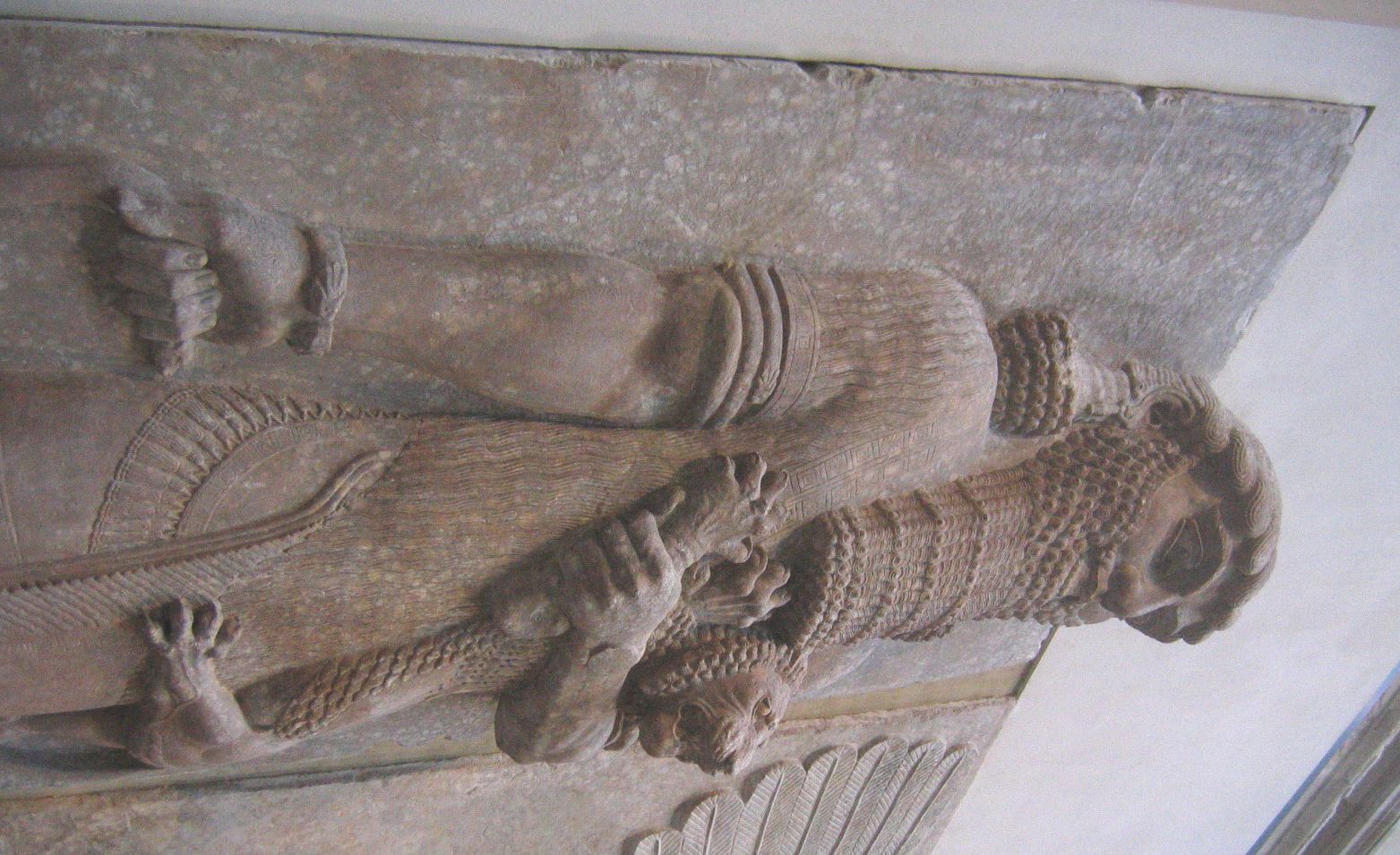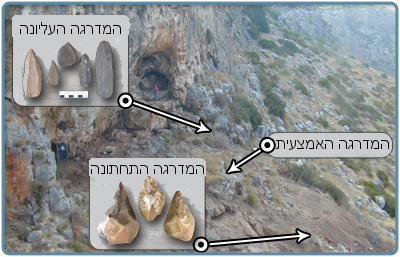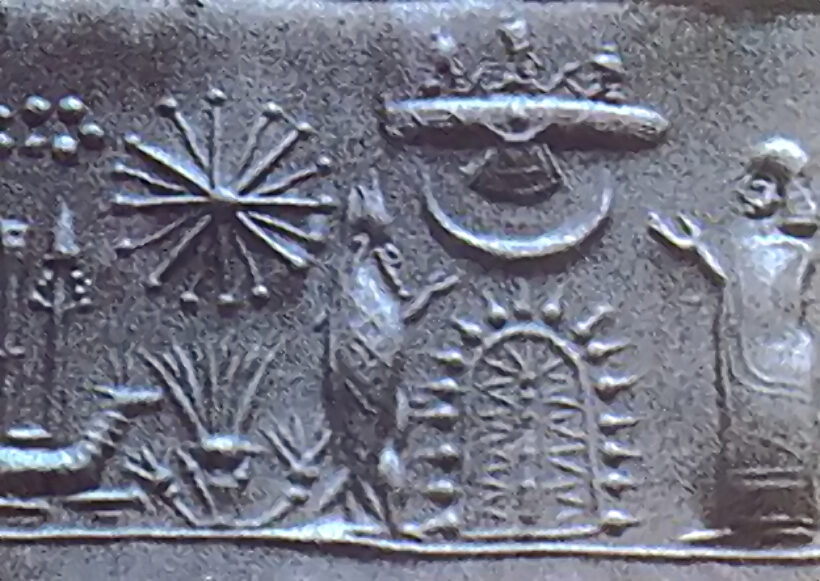First-millennium seal shows a worshipper and a wise man dressed as a fish before a stylised tree with a crescent moon and a winged disc above it. Behind this group is another plant form with a radiant star and the star cluster (Pleiades cluster) above. In the background is the dragon of Marduk with the spear of Marduk and the standard of Nabu on his back.
Javier Belda
This is the rapture of those beings not understood in their intimate nature, great powers that made everything known and yet unknown.
This is the rhapsody of the external nature of the gods, of the action seen and sung by humans who could stand at the vantage point of the sacred.
This is that which appeared as a sign fixed in eternal time capable of upsetting order and laws and poor sanity. That which mortals wished the gods to do; that which the gods spoke through men. [1]
With these captivating words Mario Rodríguez Cobos (Silo) begins his journey through some significant myths in various cultures, in his book Mitos raíces universales (Universal Roots Myths).
Myths can show us that the differences between contemporary man and the primitive man of thousands of years ago do not really exist, in the essentials our preoccupations are identical.
Since ancient times there has been a need to forge an image that gives meaning to existence.
Myth represents a time tunnel that offers us the possibility of travelling back thousands of years to enter the mental spaces of our ancestors. There, attempts, frustrations and discoveries about the mystery of life are fossilised.
The same thing that drives the hero to undertake an initiatory journey is at work in each one of us: to give meaning to our existence, to create our own life story.
The Epic of Gilgamesh is about the precariousness of the human condition due to the impossibility of being immortal. “He built the walls of Uruk, went on a long journey and learned all that happened before the Flood. On his return he recorded all his exploits on a stele”.
Man has been created mortal, and his only reason for being is to be in the service of the gods. But this myth finally leaves a glimmer of hope, implying that some beings could attain immortality on their own, without the divine gift, but only on condition that they are victorious in a series of trials.
 Ancient Assyrian statue now in the Louvre Museum, possibly representing Gilgamesh. Wikimedia commons
Ancient Assyrian statue now in the Louvre Museum, possibly representing Gilgamesh. Wikimedia commons
With the passage of time, the profound meanings of these fascinating stories were lost, placing them in the realm of fantasy. However, through the investigation of myths it is possible to interpret a substratum of values and beliefs that will become the pillars of an entire civilisation; in this case the Sumerian-Akkadian Civilisation.
Historians argue that there is nothing irrelevant in the reconstruction of myths; even a falsification or omission can shed light on other implicit contents. But there is no doubt that many treasures have been lost through the multiple cultural superimpositions of different historical moments.
One difficulty that goes more unnoticed is that of our mental form. We will not dwell here on the exciting subject of the forma mentis. Let us just observe that, today, we have parcelled knowledge towards the monolithic, moving away from what was once a holistic mental form. There was a time when science, art, religion, hunting, love, death, subsistence or magic were one and the same. This current eagerness to separate things makes it difficult for us to understand our process and place in the world of spiritual essences.

Misliya Cave, Middle East. A new archaeological find will force a rewriting of human history. According to a fossil found between 200,000 and 175,000 years old, humans began to conquer the world 60,000 years earlier than previously thought and interbred with Neanderthals. ru.m.wikipedia.org
Moving between doubt and certainty
In the meantime, archaeology is coming up with uncomfortable new findings, pushing the beginnings of human culture further and further back in time. Many of the “axiomatic” concepts that have been taken for granted and handed down from one generation to the next are now being clearly and scientifically questioned.
In archaeological research, chronological paradoxes occur one after the other, and the appearance of contents common to many cultures, although supposedly separated by thousands of kilometres, is also striking.
The myths refer to the struggle or coexistence between opposites in the emergence of religions: order and chaos, light and darkness, life and death, etc. In all cultures we find this duality.
The suspicion then arises that the philosophical and moral question of YES and NO is part of the human, something that is in our condition but something that we need to resolve throughout our peculiarity of existence, the “what for” of existence itself.
No myth solved the problem of immortality automatically, as an ideal outcome, rather, all myths show the importance of the way and, of course, there are myths that deny the meaning.
Theognis, Pindar, Sophocles proclaim that the greatest good fortune that could befall humans would be not to be born or, once born, to die as soon as possible. But death did not solve anything either, since it did not mean total and definitive extinction. For Homer’s contemporaries, death meant a further diminished and humiliating existence in the unearthly darkness of Hades (populated by pale shadows devoid of force and memory).
[On the other hand, good done on earth went unrewarded and evil went unpunished. The only ones who were tortured for eternity were Ixion, Tantalus, Sisyphus, for having offended Zeus himself.[2]
How can we fail to see in this the shadow of a hierarchical thinking deeply rooted in Western culture since Greek mythology!
Just by way of a note on such a vast subject: “This pessimistic conception took hold when Greek man became conscious of the precariousness of the human condition. The Greeks learned that the best way to escape time is to exploit the riches, unsuspected at first sight, of the living instant” (Eliade, 1976).
Conversely, we can also cite the Apollonian lesson par excellence expressed in the famous Delphic formula: “Know thyself”.
Beyond specialised interpretation, the consideration of myths in their emotional aspect is a subjective work, in which everything has not been described, but it is up to each one to find the essential meanings.
It is the inner resonance with the evolutionary process that allows us to recognise ourselves in the human species. In doing so we can experience that we are part of something greater that transcends our individuality. Current science, for example, speaks unabashedly of a possible conscious pseudo-neural cosmic network.
In the advance towards who knows what, we glimpse the trend towards a Universal Human Nation, which today requires multipolarity in order to be realised. We seem to see in this a synthesis of the human process, the no end of a millenary path and the beginning of a new stage.
Discovering a renewed meaning in the traces of the past goes beyond the simple collection of data to become a passion that revolutionises consciousness. In the commonality of these traces, we glimpse something millenary but totally valid.
[1] Silo. Universal Roots Myths. Gilgamesh – Poem of the Lord of Kullab. Ed. Antares Ediciones S.A., 1992.
[2] Mircea Eliade. History of Religious Beliefs and Ideas I., 1976.






